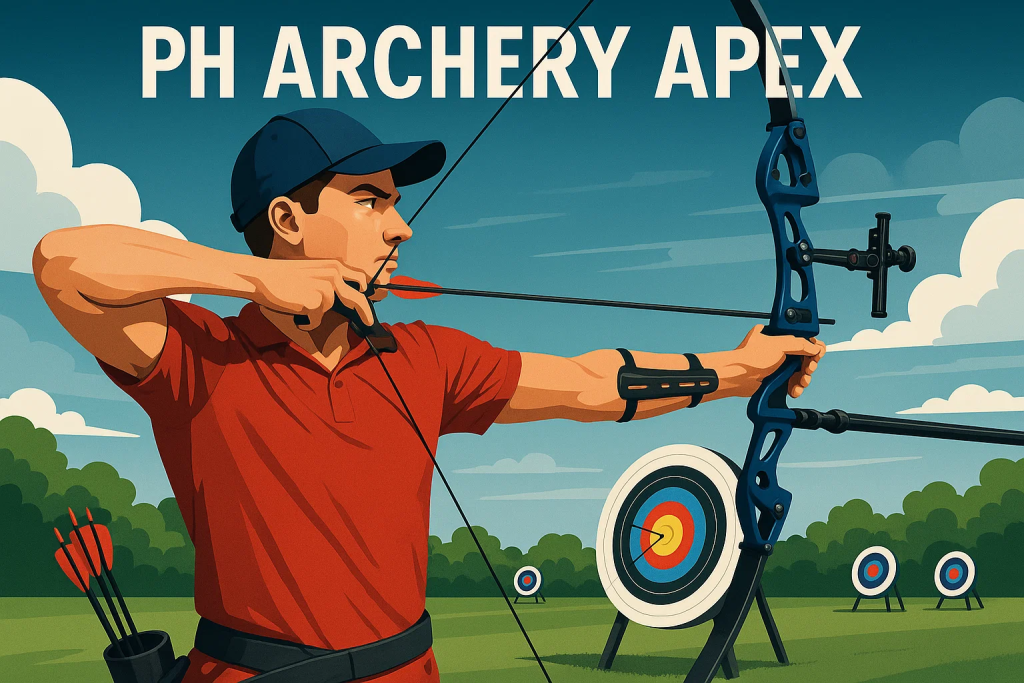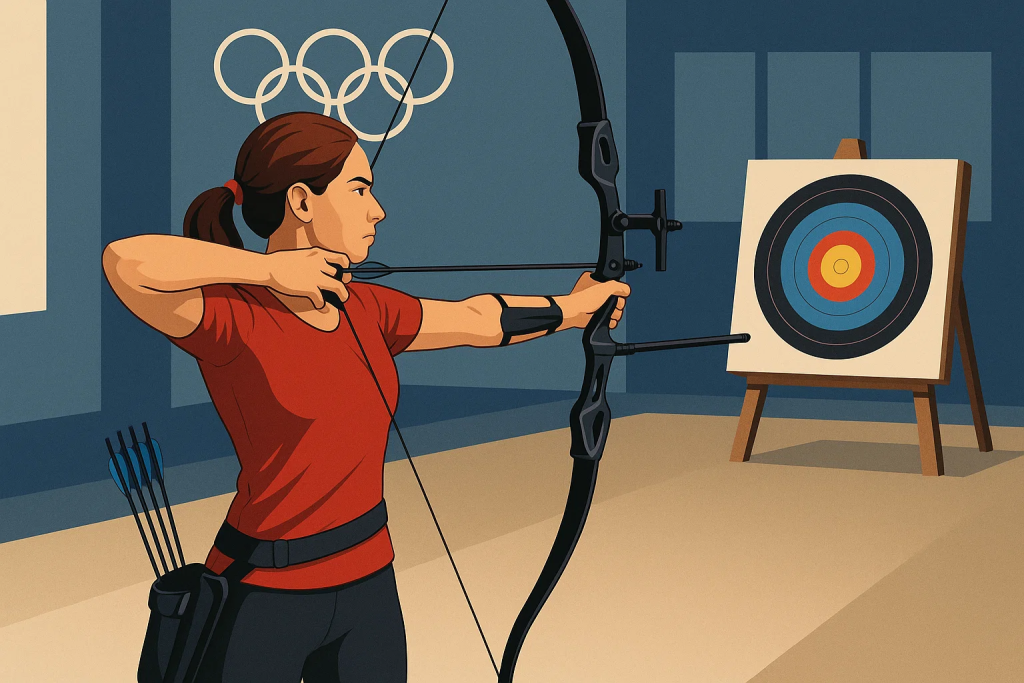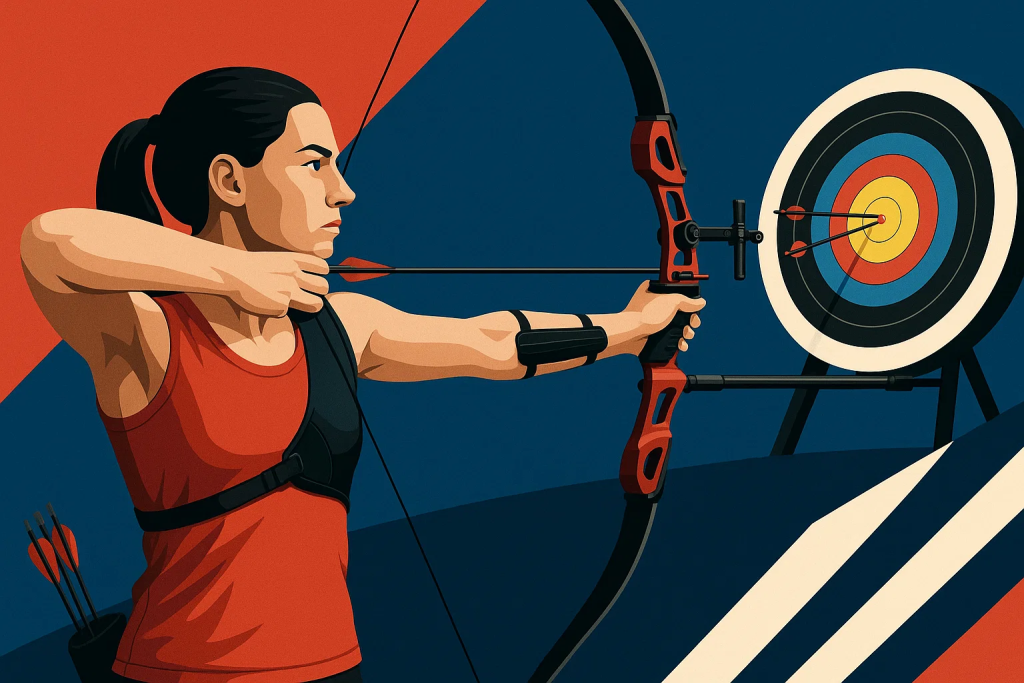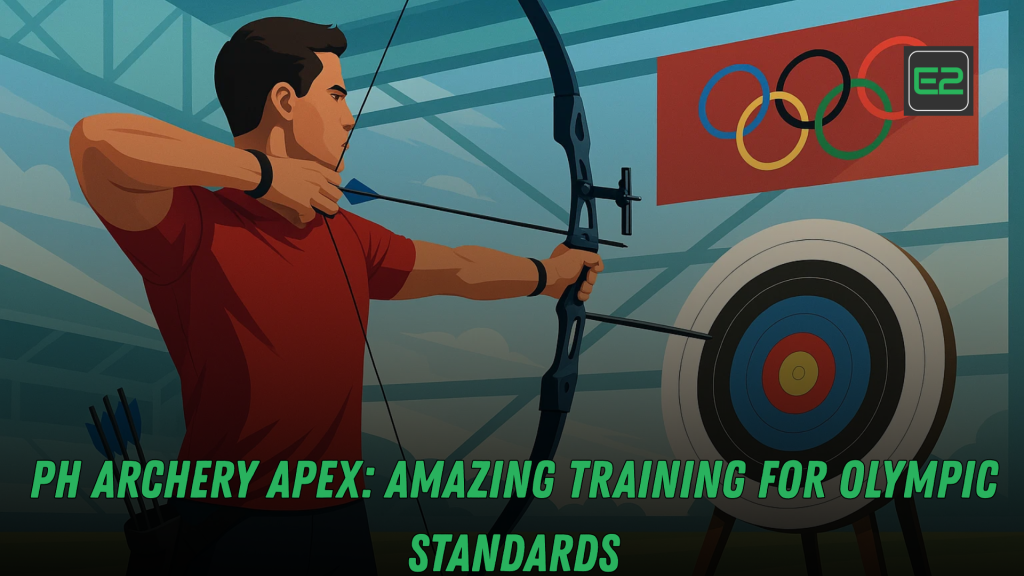Table of Contents
The Philippines has been quietly building a modern high-performance pathway toward the Olympic podium. At the heart of that journey is archery—a sport that blends biomechanics, breath control, grit, and data in a way few others do. This in-depth guide turns “PH Archery Apex” from a slogan into a step-by-step operating system for athletes, coaches, and program heads.
You’ll learn how to translate Olympic criteria into daily habits, how to periodize the year, how to fix technique under pressure, and how to build a culture that keeps new talent coming. Whether you’re a junior archer, a collegiate coach, or a national team administrator, the goal is the same: make the next shot your best shot—and make that improvement repeatable.

Executive Summary
- Olympic standards are not just scores; they’re a repeatable process of shot quality, health, and decision-making.
- Build a “Gold Loop”: assess → adjust → absorb → apply.
- Anchor the program around five pillars: archery technique, strength & conditioning, mental performance, recovery, and analytics.
- Use clear KPIs—arrow group size at 70m, end-to-end timing, heart-rate drift, and pressure-test scores—to drive training decisions.
- Grow the base: school leagues, talent IDs, and coaching clinics create a resilient pipeline beyond one Olympic cycle.
The PH Archery Apex Vision
PH Archery Apex is a blueprint for world-class archery that fits local realities—tropical climate, school calendars, travel budgets—without lowering the bar. It aligns athlete development with Olympic benchmarks: 70m accuracy for recurve, robust bow control, and match-play resilience. The vision insists that performance emerges from systems, not streaks: simple checklists, tight feedback loops, and a shared language across clubs, schools, and national teams.
Olympic Standards, Demystified
What does “Olympic level” actually mean for archery? It means stable 70m groups in the low tens under variable wind, a clean shot cycle that holds up past the 250th arrow of the day, and match composure when the set score hits 4–4. It also means staying healthy over months, not just peaking in one weekend. In practical terms: movement economy, reproducible anchors, predictable follow-through, and consistent timing between breath and release. When we say “Olympic standards,” we’re translating big dreams into small, controllable behaviors that compound.
Biomechanics That Make the Shot
Elite archery form is a geometry problem solved by human tissue. Think of five alignments:
- Feet–hips–shoulder line: neutral stance width, pressure balanced across the tripod of the foot.
- Bow arm stack: shoulder down and set, elbow rotation that clears the string line, wrist neutral to transmit load through the skeletal system.
- Draw side chain: scapular motion initiates, not the hand; lat engagement glides the elbow around the ribcage.
- Head–anchor architecture: jawline consistent, string contact repeatable (tip of nose, corner of lips), eye focus soft but centered.
- Follow-through: expansion continues after release as if the arrow is still on the string—because, neurologically, it is.
Biomechanics is where “feel” meets physics. If one joint compensates, another joint protests. Great archery protects the joints by letting bones carry load and muscles fine-tune direction.
Technique Blueprint: The 7-Step Shot Cycle
A shared language turns coaching into a science. Use this seven-step sequence to make archery form teachable:
- Set: feet set, posture tall, breath down.
- Set-up: bow shoulder packed, wrist neutral, eyes on center.
- Draw: scapular glide initiates; hand is a passenger.
- Anchor: string–nose–chin touchpoints lock.
- Transfer & hold: load shifts from arms to back; sight picture quiets.
- Expansion: slow, even pressure through the line of the arrow.
- Release & follow-through: fingers relax; elbows travel; balance remains.
Each step has one cue. When pressure rises, simple beats clever. The best archery coaching trims words, not standards.
Equipment That Serves the Athlete
Good gear doesn’t win tournaments—clear choices do. Work backward from feel and groups:
- Limb weight: choose a poundage you can draw 200 times with form intact; chasing heavy limbs early is an injury plan, not a performance plan in archery.
- Riser fit: neutral grip that prevents torque; experiment with subtle grip shims before switching risers.
- Tuning: bareshaft at 30m, paper test for tear pattern, button pressure matched to arrow spine.
- Stabilization: front and side bars chosen for balance under wind, not just indoor stillness.
- Sighting: clean ring, minimal clutter; your brain should see one job.
Athletes evolve; so should setup. Log changes. If a tweak doesn’t hold up across three sessions, revert.
Periodization: From Base to Podium
Map the season so your nervous system knows what’s coming. A classic archery year can look like this:
- Base (8–10 weeks): volume, mobility, and form errors hunted gently.
- Build (6–8 weeks): intensity rises; 70m becomes home; match simulations appear weekly.
- Peak (3–4 weeks): volume trims, speed of decision rises, travel rehearsals begin.
- Transition (2–3 weeks): deload, review, goal reset.
Write the plan. Then live it. The brain calms when it recognizes the rhythm.
Range Setup and Tropical Realities
Olympic-level archery in the Philippines means sun, humidity, and wind that changes its mind at noon. Win the environment:
- Wind lanes: flag ribbons every 10m; learn to stack cues (grass, ropes, face feel).
- Heat: shade tents, cold towels, electrolyte plan, and a pre-cool routine on hot days.
- Rain: tarp drills, waterproof quivers, silica packs for sights.
- Light: polarized lenses and cap brims tuned to target contrast.
Make the range a classroom for nature. When the environment surprises less, scores drop less.
Strength and Conditioning Built for Bows
The strongest archery athletes look normal until they pull. Train tissues to match the job:
- Scapular control: Y–T–W raises, serratus wall slides, banded external rotations.
- Posterior chain: hinge patterns, split squats, glute bridges to anchor the lower body.
- Core anti-rotation: Pallof presses and dead bugs to resist torque.
- Grip & forearm endurance: rice bucket, extensor bands, timed holds.
Programming rules: quality before load, tempo before ego, and symmetry before maxing. Lifting supports archery, not the other way around.
Mobility and Injury Prevention
Mobility is permission, not a party trick. Build a 12-minute daily circuit:
- Thoracic rotations, first rib glides, pec minor release.
- Wrist flexor/extensor flossing, forearm massage.
- Hip openers and ankle dorsiflexion for stable stance.
The job is simple: keep the joints that must move moving, and the joints that must stabilize stable. Healthy archery is boring—and that’s good.
Mental Performance: Pressure Is a Skill
At 4–4 in a set, physiology screams. Train the mind the way you train the bow:
- Breath ladder: inhale 4, hold 4, exhale 6, hold 2; repeat to find neutral.
- Self-talk scripts: brief, present, actionable (“strong bow arm,” “calm sight,” “flow through”).
- Process goals: judge shots by execution, not just score.
- Pressure ladders: teammates watch the last three arrows; add a small consequence; repeat.
In elite archery, courage isn’t absence of fear; it’s a plan that still works while fear rides along.
Nutrition, Hydration, and Heat Strategies
Sustained focus drinks water. Build a simple archery fueling plan:
- Before: balanced meal 2–3 hours out; small carb + protein snack 60 minutes out.
- During: 150–250 ml fluids every end; electrolytes on humid days; light bites between sets.
- After: protein + carb within an hour; easy walk and stretch.
Caffeine timing, salt intake, and gut tolerance are personal. Test in training, never on finals day.
Data and Analytics Without the Hype
Numbers clarify, not complicate. Track what drives archery decisions:
- Group radius at 70m (cm), not just score.
- Shot timing (draw to release) and variance.
- Perceived exertion and heart rate drift across ends.
- Context tags: wind rating, heat index, time of day.
Review weekly. Kill one metric that didn’t help. Keep only what changes behavior.
Coaching Systems and Language
Great coaching is consistent language multiplied by reps. Build a shared glossary for archery cues, a library of demo videos, and a rule that each correction contains a “do” rather than a “don’t.” Use constrained drills (“no clicker for three arrows,” “eyes closed at anchor,” “group to the left half only”) to let athletes feel solutions. The best systems work even when the head coach is out sick.
Talent ID, Selection, and Camps
Apex programs widen the door and raise the ceiling. Publish transparent selection criteria—objective scores, improvement curves, and health metrics—and then run camps where aspiring athletes feel seen. In archery, some progress slow-burn; reward trajectory, not just one hot weekend. Camps should test physical literacy, resilience, and coachability, not just raw points.
Travel, Tapers, and Competition Rhythm
Race day feels easy if the week before was smart. For archery events, taper volume, keep intensity, and lock a routine:
- T-7: normal practice, last heavy S&C.
- T-5: form sharpness, match sims, no new gear.
- T-3: deload S&C, polish timing, travel packs ready.
- T-1: thirty arrows to feel, stretch, deactivate.
At the venue, create a micro-home: same warm-up, same cue words, same water plan.
Community, Clubs, and Grassroots Growth
Olympic dreams rest on local fields. Clubs that teach safe range etiquette, fun games, and gentle competition will keep kids. Family days, school visits, and open house shoots feed the funnel. The more people who try archery once, the more who will love it for life. Pipeline beats pressure.

A 16-Week Olympic-Standard Plan (Sample)
Weeks 1–4 (Base):
- Form rebuild: seven-step cycle, light limbs, 150–200 arrows/session.
- S&C: scapular control, hinges, core anti-rotation; easy aerobic.
- Metrics: group radius at 30–50m, timing variance, RPE log.
- Goal: consistent anchors and quiet sight picture—foundations for archery under stress.
Weeks 5–8 (Build I):
- Step to 70m; wind reading three times/week.
- Match simulations Fridays; video review Mondays.
- S&C maintains; add grip endurance and split squats.
- Goal: stable 70m group radius trending down.
Weeks 9–12 (Build II):
- Intensify: fewer arrows, more purpose; add pressure ladders.
- Travel rehearsal: pack, sleep bank, morning and afternoon sessions.
- Nutrition dial-in under heat.
- Goal: finals routine built; archery under noise feels familiar.
Weeks 13–16 (Peak & Taper):
- Volume trims 20–30%; intensity and precision stay.
- No gear changes; mental scripts locked.
- Taper into competition week as above.
- Goal: calm autonomy, ready body, predictable shot.
KPIs and Scorecards That Matter
- 70m group radius (cm) and trend line by wind class.
- Shot timing variance (consistency beats speed).
- Pressure-block delta: score drop from solo practice to watched practice.
- Health index: sleep hours, soreness scale, shoulder ROM.
- Travel resilience: first-session score post-flight vs season baseline.
Scorecards focus attention. In elite archery, attention is oxygen.
Brand, Story, and Support
Apex programs thrive when fans and sponsors can see themselves in the story. Show the work: early mornings, rewired form, sweaty range resets, and quiet wins. Celebrate volunteers, junior breakthroughs, and coaches who say “I don’t know—let’s test it.” Authentic archery storytelling builds the village an Olympian needs.
Common Pitfalls (and Fixes)
- Chasing poundage: fix movement first; strength is a servant in archery.
- Changing too much at once: one tweak per week; log everything.
- Ignoring heat: dehydration looks like bad form; treat the cause.
- Skipping strength: shoulders pay for it later.
- Talking instead of drilling: constraint drills beat lectures.
Case Study (Composite)
A provincial club identified three juniors with calm eyes and tidy posture. They shifted to a low-variance shot cycle, trimmed limb weight, and built a weekly schedule that paired technique with breath and core work. Within eight months, 70m groups shrank by 20 percent, match-play confidence rose, and one athlete qualified for an international youth meet. The recipe wasn’t magic—just disciplined archery habits and a coach who loved the boring fundamentals.
The Culture That Outlasts One Cycle
Banners fade; systems compound. Meet weekly as a staff, share errors before wins, and keep a living playbook. When a departing senior leaves pages of notes for the next junior, you know archery culture is working. The PH Archery Apex ideal is not just medals; it’s a community that breathes dignity, curiosity, and care.
Call to Action
If you’re an athlete, pick one micro-habit to own this week: a 12-minute mobility circuit, a breath ladder before ends, or a two-sentence shot script. If you’re a coach, choose one metric to track and one drill to simplify. If you run a program, publish your selection criteria and run an open clinic. The next Olympic arrow is already in the air. Aim it with intent. Build the habits. Share the playbook. And let the Philippines show the region how modern archery is done—quietly, consistently, and with joy.
PH Collegiate Chess Team: Brilliant Training for Global Events
Final Word
An arrow’s flight is simple physics guided by messy biology. PH Archery Apex takes that mess and makes it teachable: clear biomechanics, humble strength, steady minds, and honest numbers. Keep the loop short. Keep the language kind. And keep showing up. Every day you practice world-class archery, you move the flag a few inches closer to Paris, Los Angeles, and beyond.

PH Archery Apex maps a practical pathway to Olympic-level archery in the Philippines. It translates standards into daily habits: a seven-step shot cycle, biomechanics that protect joints, sensible equipment tuning, and data-driven KPIs such as 70m group radius and timing variance.
The program pairs range work with strength, mobility, heat strategies, and nutrition; builds mental resilience through breath ladders, scripts, and pressure drills; and periodizes the year from base to peak. It emphasizes tropical realities, safe range setups, and community pipelines. Coaches use shared language and selection criteria; athletes follow 16-week plans. Culture, not streaks, sustains consistent performance and longevity.
Frequently Asked Questions
1) How many arrows should I shoot per session when building Olympic habits?
For most developing athletes, 150–250 purposeful arrows is plenty, provided form quality stays high and you close with a cooldown. In archery, more is not more if technique degrades; use tight goals and stop before slop.
2) What’s the fastest way to stabilize my groups at 70m?
Lock the seven-step shot cycle, tune limb weight so you can finish strong, and practice wind reading with flags every 10m. Add pressure ladders once a week so your archery timing survives nerves.
3) How should I combine strength training with range time?
Place heavier lifts on light shooting days or after technique drills, not before. Prioritize scapular control, posterior chain, and anti-rotation. Strength supports archery precision by preventing fatigue-induced form collapse.
4) What mental routine works best in match play?
Keep it short: a breath ladder, two cue words, and a clean visual of the sight settling. Use the same routine in practice. Consistency turns stress into signal; your archery brain recognizes the pattern and relaxes.
5) Which KPIs matter most to coaches?
Track 70m group radius, timing variance, and a simple pressure delta from solo to watched ends. Add a health index. These reveal whether your archery plan is building durable performance or just chasing streaks.
